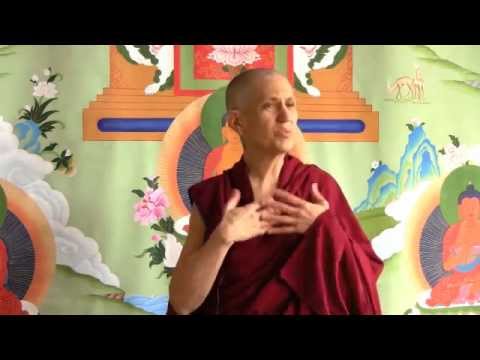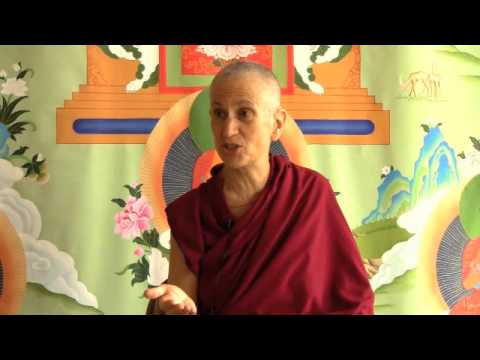Attachment to personal identity
A Crown Ornament for the Wise, a hymn to Tara composed by the First Dalai Lama, requests protection from the eight dangers. These talks were given after the White Tara Winter Retreat at Sravasti Abbey in 2011.
- Attachment to our identity
- The importance of changing our environment
- How being in a new place with different people gives us opportunity to change our habitual patterns
The Eight Dangers 17: The flood of attachment, part 3 (download)
Sweeping us in the torrent of cyclic existence so hard to cross,
we’re conditioned by the propelling winds of karma.
We are tossed in the waves of birth, aging, sickness and death:
The flood of attachment—please protect us from this danger!
Okay, so we’ve been talking about attachment and asking Tara to please protect us from that fear. From that danger.
And this morning Yeshe and I were talking about one form of attachment—when we get attached to who we think we are. You know? We grow up in a certain environment, or we live in a certain environment, for a long time and we develop a whole identity of who we are, and we never question it until we go to another environment and then we don’t know who we are anymore. Because people are treating us differently, and the rules are different, and we’re different, and everything’s different, and we feel like, “who am I?” Yes? I see a lot of nodding heads here. [Laughter]
So this is actually … I think it’s something that’s very essential in Dharma practice. And that’s why in The 37 Practices of Bodhisattvas, one of the early verses counsels us to “leave our homeland.” So “our homeland” actually refers to—internally—our own conceptions of who we are and our own patterned responses and habitual emotional responses. But it’s hard to change those when we’re in the same environment that always conditions us in the same way. If we go to a new environment with different conditioning there’s a lot of space to become a different person. But it also can be a little bit unnerving.
So it’s actually quite nice, because it allows us to experiment with different ways of being. Because when we’re in our old environment—especially with family and old friends—we all know each other’s buttons. We all know what to do to please somebody, and what to do to make them mad. And we just play out the same dramas again and again, don’t we? And often make the same mistakes again and again, and we wonder why we’re so unhappy.
When you go to a different environment, and people are treating you differently, then there’s space to not just do the same old things. And not just have the same old emotions in response to the same old stimuli. But to really think, you know, “Okay, somebody said that. Well, what does it really mean?” In other words, there’s some space to really consider the situation and to change our response to it.
So this is what we’re trying to do in Dharma practice, is to change our internal responses to the same old stuff. So having a different environment often gives us that space to do that.
Because the thing is, too, that certain situations … like, people who criticize us, okay? We’re going to find them wherever we go. It’s impossible. People who bug us, we’re going to find them wherever we go. Why? Because we have the seeds of anger, agitation, irritation, and so on, in our own minds. So everywhere we go, we’re going to see those people. Right? But, sometimes going to a different place give you the internal space to respond to them differently, because you see that your old responses are like a prison. And we’re stuck in our old responses and they’re making us miserable.
Remember some time ago I gave a whole talk about how we dig ourselves holes. The hole is our self-identity. And we furnish our holes with “I like this and I don’t like this. And treat me this way and don’t treat me that way. And you can talk to me about this, but you cannot talk to me about that. You can question me about this, but you cannot question me about that.” With all of our rules, you know, this nice decorated hole. And then we sit in it and we feel, “Oh, I’m so confined I can’t get out I’m stuck. This is so horrible” But who dug the hole and who decorated it? We did.
So we’re trying to get out of our holes and see that there’s a whole world around there and we don’t need to stay in our holes and we don’t need to decorate them.
I really think we should do some skits sometime about our holes.
Venerable Thubten Chodron
Venerable Chodron emphasizes the practical application of Buddha’s teachings in our daily lives and is especially skilled at explaining them in ways easily understood and practiced by Westerners. She is well known for her warm, humorous, and lucid teachings. She was ordained as a Buddhist nun in 1977 by Kyabje Ling Rinpoche in Dharamsala, India, and in 1986 she received bhikshuni (full) ordination in Taiwan. Read her full bio.


